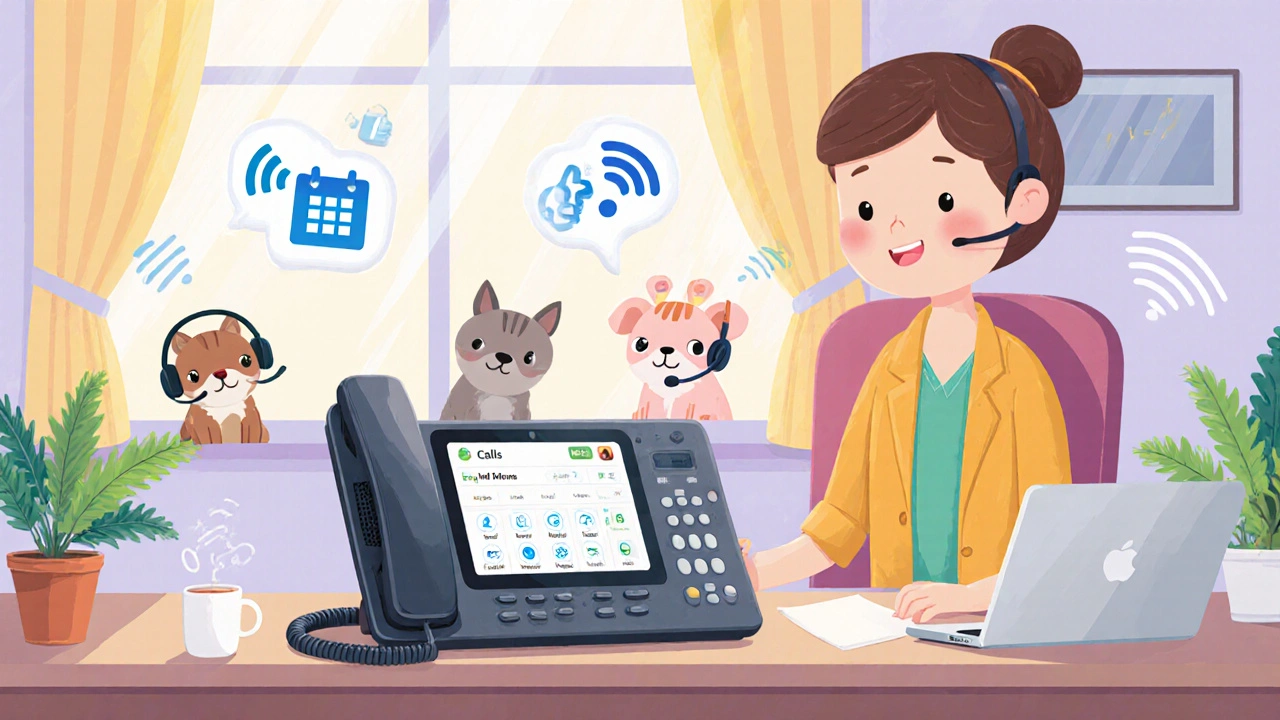When your team is spread across offices, homes, and coffee shops, how do you make sure everyone can make and take calls without dropping connections, losing clarity, or wasting time switching between apps? The answer isn’t choosing between a desk phone and a softphone-it’s knowing when to use each.
What Exactly Is a Desk Phone in a UC System?
A desk phone in a unified communications setup isn’t your old landline. It’s a modern IP phone that connects directly to your company’s network via Ethernet, not copper wires. These devices have physical handsets, dedicated buttons for speed dial and hold, and often a color screen showing caller ID, call duration, and even calendar events. Brands like Cisco, Yealink, and Poly dominate this space, with models that support Power over Ethernet (PoE), meaning they draw power through the same cable that gives them internet access.These phones are built for one thing: making calls. No distractions. No pop-ups. No background apps. That’s why contact centers still rely on them. Tragofone’s 2024 study found reps using desk phones handled calls 15-20% faster than those using softphones. Why? Because their brain isn’t juggling Slack messages, emails, and calendar alerts while trying to resolve a billing issue.
Sound quality? That’s where desk phones still lead. Vitel Global’s testing showed 30-40% fewer dropped calls and noticeably clearer audio, especially in noisy environments. That’s thanks to dedicated DSP chips and noise-canceling mics designed for voice, not just copied from a laptop webcam. Most enterprise-grade desk phones deliver a Mean Opinion Score (MOS) of 4.4-4.6-close to landline clarity.
What Is a Softphone, Really?
A softphone is software. It runs on your laptop, tablet, or phone. Microsoft Teams, Zoom Phone, RingCentral, and Google Voice are all softphone platforms. Instead of picking up a handset, you click a button in an app. You can take a call while walking to the printer, hopping on a train, or working from your couch.Softphones aren’t just about mobility-they’re about integration. They tie directly into your CRM, calendar, email, and chat tools. If a client calls and you’re in Salesforce, their info pops up automatically. If you’re in a meeting, the softphone can auto-pause your call and send it to voicemail. That’s why 92% of softphone deployments integrate with CRM systems, compared to just 65% for desk phones.
But here’s the catch: softphones depend entirely on your network. If your Wi-Fi is spotty or your upload speed dips below 100 kbps per call, audio breaks up. TechAdvice.com’s 2023 survey found 34% of softphone users reported audio issues during peak network usage. That’s not the software’s fault-it’s the infrastructure. John Riordan of UC Today warns: “Organizations that skip network assessment before rolling out softphones are setting themselves up for frustration.”
Cost Comparison: Upfront vs Ongoing
Let’s talk money. A single desk phone costs $80-$400 upfront. Add in installation, network configuration, and training, and you’re looking at $150-$600 per user in the first year. Monthly line fees? $50-$80 per device.Softphones? No hardware cost. You pay $10-$60 per user per month, bundled into your UC subscription. That’s why startups and remote-first companies lean hard on them. Nurango reported 40-60% lower initial costs for softphone-only setups. One healthcare provider saved $18,500 annually by replacing 45% of its desk phones with softphones on tablets for nurses on the move.
But don’t assume softphones are always cheaper. If your network needs upgrades-better routers, QoS settings, or even a dedicated internet line-you’ll eat into those savings. And if you need high-end headsets, noise-canceling microphones, or dual monitors for call handling, those add up fast.

Which One Works Best for Your Team?
There’s no universal winner. The right choice depends on role, location, and workflow.- Frontline staff in call centers: Desk phones. The physical interface reduces cognitive load. Agents handle 20-30% more calls per shift with fewer errors.
- Remote workers and field staff: Softphones. They can answer calls from anywhere without carrying extra gear. Employee satisfaction jumps 35% when remote teams get softphones.
- Executives and managers: Hybrid. They need the polish of a desk phone in the office, but the flexibility of a softphone when traveling.
- Compliance-heavy roles (finance, healthcare): Desk phones still have an edge. Dedicated hardware is easier to audit and secure. But modern softphones now support TLS 1.3 and SRTP encryption, closing the gap.
Gartner recommends a 60-70% desk phone, 30-40% softphone mix for most mid-to-large enterprises. That’s not arbitrary. It’s based on real usage patterns: 78% of contact centers still prefer desk phones for frontline agents. But 82% of hybrid teams report higher satisfaction when both options are available.
Hybrid is the New Standard
The future isn’t desk phones or softphones. It’s both-working together.Cisco’s 8800 Series desk phones now include built-in softphone modes. You can start a call on your desk phone, then seamlessly hand it off to your phone as you leave the office. Microsoft Teams’ November 2023 update does the same: if you’re in a meeting on your laptop and your phone rings, it rings on your desk phone too. Context-aware routing is coming fast. By 2026, Gartner predicts 80% of enterprises will use systems that auto-route calls based on your location, calendar, and network health.
That’s the real win: not choosing one device, but letting the system choose for you. If you’re at your desk, the call goes to your desk phone. If you’re walking to the cafeteria, it switches to your phone. If you’re on a plane, it routes to your laptop. No one has to remember which device to use.
Common Pitfalls and How to Avoid Them
Most failures in UC endpoint strategy aren’t about the tech-they’re about the rollout.- Skipping network checks: 42% of softphone deployments fail because companies don’t test bandwidth or prioritize voice traffic. Run a network assessment before you buy.
- Forcing softphones on everyone: Older staff or those in high-noise environments (warehouses, hospitals) struggle with softphones. Offer choice.
- Buying too many desk phones: If 40% of your team works remotely, why pay for 100 desk phones? You’re wasting money.
- Ignoring training: Desk phones need 30-60 minutes of training. Softphones? 2-3 hours. Don’t assume everyone knows how to use a Teams call button.
- Using multiple tools: If your team uses Zoom, Teams, RingCentral, and desk phones without integration, productivity drops 25-30% from context switching. Pick one platform and stick with it.

What’s Next? The Evolution of UC Endpoints
The endpoint market is shifting fast. In 2022, desk phones made up 58% of enterprise UC devices. By 2025, Frost & Sullivan predicts softphones will hit 55%. But desk phones aren’t disappearing-they’re evolving. The ones that survive will be smarter: with AI noise suppression, automatic call logging, and direct integration with workplace sensors.Meanwhile, softphones are getting better at sound. Modern codecs like Opus and SILK have narrowed the MOS gap to just 0.2 points-barely noticeable in real use. For most businesses, the difference isn’t worth the cost of hardware.
The real challenge? Avoiding fragmentation. IDC found 63% of companies use three or more communication tools without integration. That’s chaos. Your team shouldn’t have to choose between a desk phone, a mobile app, and a web portal. They need one seamless system that adapts to them-not the other way around.
Final Decision Framework
Still unsure? Use this simple checklist:- Do they make 50+ calls a day? → Desk phone.
- Do they work from home, travel, or move around? → Softphone.
- Is compliance critical (HIPAA, MiFID II)? → Desk phone preferred, but softphones with EDR are now acceptable.
- Is your network stable and prioritized for voice? → If no, delay softphone rollout until it is.
- Do they use CRM, calendar, or chat tools daily? → Softphone wins for integration.
- Are you scaling fast or cutting costs? → Softphone lowers upfront spend.
There’s no perfect device. There’s only the right mix for your people.
Are desk phones more reliable than softphones?
Yes, in controlled environments. Desk phones have dedicated hardware, PoE power, and noise-canceling tech that reduces dropped calls by 30-40% compared to softphones on Wi-Fi. But if your network is strong and your softphone is on a wired laptop with a good headset, the difference becomes negligible.
Can I use a softphone without a headset?
You can, but you shouldn’t. Using laptop speakers and mic leads to echo, background noise, and poor call quality. Most softphone users report better results with even a basic USB headset. For call center staff, a professional noise-canceling headset is non-negotiable.
Do softphones work on cellular data?
Yes, but with risks. A stable 4G or 5G connection can handle a softphone call, but cellular networks aren’t designed for consistent voice traffic. Packet loss spikes during congestion, causing choppy audio. Use cellular only as a backup-not a primary option.
Which is better for hybrid work: desk phones or softphones?
Neither alone. Hybrid work demands both. Desk phones give office workers reliability and focus. Softphones give remote workers flexibility and integration. The best setups use both-automatically routing calls based on where the user is and what device they’re using.
Is it worth upgrading from old desk phones to new ones?
Only if your current phones are over 5 years old. Newer models support better codecs, HD audio, and direct integration with UC platforms like Teams or Zoom. If your desk phones still work and sound fine, there’s no rush. But if you’re rolling out softphones, upgrading desk phones to compatible models ensures seamless handoff between devices.
Can I use a softphone with my existing desk phone system?
Yes, if your system supports SIP and your UC platform is compatible. Most modern desk phones (Cisco, Yealink, Poly) can coexist with softphones on the same platform. The key is unified management-using one admin portal to control both hardware and software endpoints.
Next Steps
If you’re evaluating your UC endpoint mix:- Survey your teams: How many work remotely? How many make high-volume calls?
- Test your network: Use a tool like iPerf to check bandwidth and latency.
- Pilot both: Give 10 desk phones and 10 softphones to different teams for 30 days.
- Measure satisfaction and call quality: Use feedback forms and call analytics.
- Build your mix: Start with 70% desk phones for office staff, 30% softphones for remote teams. Adjust based on results.
The goal isn’t to replace one with the other. It’s to give your team the right tool for the job-every time, every call.
